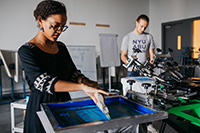-
Academics
-
Admissions
 Your journey to NYUAD starts here. Attend an application workshop or information session.Admissions Events
Your journey to NYUAD starts here. Attend an application workshop or information session.Admissions Events -
Research
-
Campus Life
 Live the possibilities. Be part of a dynamic community of students from over 115 countries.Take a Tour
Live the possibilities. Be part of a dynamic community of students from over 115 countries.Take a Tour - Public Programs
-
About
Exceptional education. World class research. Community-driven.Our Story
- News
- Events
- Social Media Directory
- Press Room
-
- Faculty
- Current Students
- Alumni
- عربي
Characterization
Existing facilities for membrane characterization at the center include: capillary flow porometer, BET, thermogravimetric analyzer, differential scanning calorimeter, dynamic mechanical analysis, liquid entry pressure, contact angle goniometer, particle size analyzer, zeta potential analyzer, and FTIR.
| Instrument | Description | Model No. |
|---|---|---|
| Differential Scanning Calorimeter (DSC) and Thermogravimetric analysis (TGA) | DSC and TGA are analytical techniques used to observe changes in a sample with temperature. | Netzsch DSC 214 Polyma |
| Dynamic Mechanical Analyzer (DMA) | DMA is a characterization tool used most commonly to study the viscoelastic behavior of polymeric materials. As membranes are predominantly polymeric, DMA helps analyze their mechanical behavior with respect to temperature and time. | Netzsch DMA 242 E Artemis |
| Particle Size Analysis | Our lab is equipped with a laser diffraction particle size analyzer with the ability to determine the size and distribution of particles for both wet and dry dispersions. Measurements can be made over nanometer to millimeter particle size ranges. | Malvern Mastersizer 3000 |
| Zeta Sizer | The zeta sizer is used to measure particle size from less than a nanometer to several microns using dynamic light scattering. It also allows measurement of electrophoretic mobility. | Malvern Zetasizer Nano ZS |
| Potentiostat/Galvanostat | Our high end, high current potentiostat/galvanostat has a bandwidth of 1 MHz and is used for electrochemical studies. This includes studying the electrochemical properties of membranes, and/or investigating electrically enhanced separation, fouling detection and/or control. | Metrohm Autolab PGSTAT302N |
| Drop Shape Analyzer | The drop shape analyzer can be used to analyze wetting and adhesion behavior on solid surfaces with temperature control. This includes contact angle measurement, free surface energy measurement and more. | Kruss Drop Shape Analyzer – DSA100S |
| Fourier-transform Infrared Spectroscopy (FTIR) | FTIR generates an infrared absorption spectrum of a solid or liquid sample over a wide spectral range. | Nicolet™ iS™ 5 FTIR with ID7 ATR |
| Capillary Flow Porometer | The pore size distribution is essential to determining rejection rates for porous membranes. Capillary flow porometry measures the pore size distribution of the through pores in membranes and other 2D materials. A wetting liquid is displaced from the sample pores by a gas at increasing pressure. | PMI iPore1500 |
| Atomic Force Microscope (AFM) | Atomic force microscopy is a high-resolution microscopy technique relying on the interactions between a probe and the material surface. | Bruker Multimode 8 |
| Micromanipulator | A micromanipulator allows us to physically interact with a sample under a microscope. | Singer MSM400 |
| Liquid Entry Pressure (LEP) tester | The Convergence Liquid Entry Pressure tester is a characterization tool that measures the minimum pressure at which wetting of the sample occurs. This is particularly useful in characterizing membranes for membrane distillation (MD) where wetting is undesirable. | Convergence Liquid entry pressure |
In addition, our lab is equipped with state-of-the-art analytical chemistry tools, which include:
| Instrument | Model No. |
|---|---|
| Dual-channel Ion Chromatography | Dionex ICS-6000 Capillary HPIC System |
| High Performance Liquid Chromatography (HPLC) | UltiMate 3000 UHPLC System |
| Gas Chromatography-Mass Spectrometry (GC-MS) | Thermo Scientific™ TSQ 9000 Triple Quadrupole GC-MS/MS System with Headspace |
| Atomic Absorption Spectrometer (AAS) | Thermo Scientific™ iCE™ 3500 AAS Flame and Furnace |
The following equipment are available for lab-scale testing:
| Instrument |
|---|
| Mini MD pilot |
| Mini RO pilot |
| Mini UF pilot |
Measurement of ultrafiltration rate/ diffusion coefficient |
| Mini MF pilot |
| Crossflow filtration unit (NF/RO) |
| Forward osmosis filtration rig |














